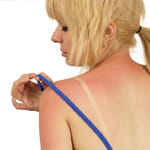- Home
- Treatments
- Aqualyx™
- Juvederm Ultra
- Sclerotherapy
- Anti-wrinkle treatment
- Laser 360
- Silhouette Soft
- Coolsculpting
- Dermal fillers
- Laser hair removal
- Skin hydration therapy
- Dermaroller
- Laser skin resurfacing
- Skin peels
- Excess sweating
- Liquid facelift
- Skin surgery
- Gel needling lift
- Obagi skin treatments
- Skin tightening
- IPL acne treatment
- Pixel™ Laser Resurfacing
- Soprano hair removal
- IPL skin rejuvenation
- Restylane
- Tear trough
- Jawline slimming
- About us
- Our clinics
- Prices
- Special promotions
- In the news
- Our blog
- Home
- Sun damage
Sun damage
Most of the damage done to your skin is before the age of 18!
Sun damage
We all need some sun exposure; it’s our main source of Vitamin D, which helps us absorb calcium for stronger, healthier bones. But it doesn’t take much time in the sun for most people to get the Vitamin D they need and overexposure can lead to sun damaged skin.
Sun damage (photodamage) of the skin can either be acute, as in sunburn or most commonly, chronic, seen as gradual changes in the skin caused by the accumulation of sun exposure. Chronic photo damage results in either cosmetic changes in the skins appearance or more seriously, medical changes in the skin such as pre-cancerous and cancerous changes (for more information regarding skin cancer click here).
The cosmetic effects of sun exposure are changes to the skins texture, tone and elasticity. In advanced damage there is a rough leathery texture to the skin, however, even the most modest sun damage results in skin laxity which contributes to fine lines and wrinkles, age spots and darker areas of increased pigmentation and dilated blood vessels.
How to repair Sun Damage
Whilst ‘prevention is always better than a cure’ if you have developed sun damage, there are a number of products (Obagi Nu-DERM, Obagi CRx)and treatments (IPL rejuvenation, Pixel Laser Resurfacing, Chemical Peels, Skin Hydration Therapy) available to try to reverse some of the signs.
Facts about Sun Exposure
Sunlight contains three types of ultraviolet rays UVA, UVB, UVC.
UVA: UVA levels are constant throughout the year and since they pass effortlessly though the ozone layer they make up the majority of our sun exposure. UVA rays penetrate deeper into the skin than UVB rays and unfortunately it is UVA, which causes most of the ageing effects seen in the skin. UVA rays can penetrate though glass so it is still important to apply a broad spectrum sunscreen daily to protect your skin whilst driving or sitting by windows. UVA tans the skin: sun-tanning beds use mainly UVA light. A UVA tan does not protect the skin from further sun damage, it merely produces colour and a false sense of protection from the sun – there is no such thing as a ‘safe’ tan.
UVB: UVB rays are needed for Vitamin D production but they are also dangerous. They penetrate the upper layers of the skin causing sunburn and they are also more carcinogenic than UVA rays. Melanomas, the most dangerous form of skin cancer, is thought to be associated with severe UVB sunburns that occur before the age of 20. UVB amounts vary and increase in the summer, at noon, and on the equator. UVB rays are not able to pass through glass.
UVC: UVC rays are the most dangerous, but fortunately, these rays are blocked by the Ozone layer and do not reach the earth.
What is a Sun Tan?

Sunbathing
Contrary to popular belief, a tan is not “healthy” – it is a sign that your skin has been damaged. When exposed to the sun’s UV rays, your skin’s melanocytes produce melanin, the dark pigment that creates a tan. Melanin (your ‘tan’) is your skin’s first defence against the sun because it absorbs dangerous UV rays before they do serious damage to your skin. Melanin is found in different concentrations and colours, resulting in different skin colours. A tan does not help protect your skin from getting sunburn in the future. A tan is equivalent to merely an SPF 4!
What is Sunburn?

Sunburn
Sunburn develops when the amount of UV exposure is greater than that which can be protected against by the skin’s melanin. UV rays penetrate deep into the layers of your skin, damaging DNA and killing living skin cells. In response to this trauma, your body’s immune system increases blood flow into the damaged area so white blood cells can remove the dead skin cells.
Even without the obvious signs of sunburn, the damage UV rays do to your skin’s DNA makes the skin thin and the good cells die and slough off. The skin is not always able to rebuild the good cells and it is also this DNA damage that increases your risk of developing skin cancer (for more information regarding skin cancer click here). Once skin is damaged, it shows on the skins surface in the form of wrinkles, age spots and freckles. Most of the damage done to the skin is done before the age of 18.
How to prevent Sun Damage
There are a number of simple ways to protect your skin from the sun. Wearing lightweight clothing, hats and protective eyewear will help and if you do need to be outside avoid the heat of the day but remember your sunscreen
Sunscreens
- All sunscreens have UVB protection which is reflected in the SPF. The SPF is only related to the UVB protection and does not provide a reference to the UVA protection in the product.
- Modern sunscreens attempt to block the whole spectrum of UV light, so are called ‘broad spectrum’ but unfortunately not all so-called broad spectrum sunscreen protect the skin from the whole range of UVA.
- If a skin burns in 10 minutes, a properly applied sunscreen with SPF 15 means they will burn in 150 minutes.
- It is important to apply sunscreen 15-30 minutes before going in the sun, apply it liberally and reapply every 2 hours.

